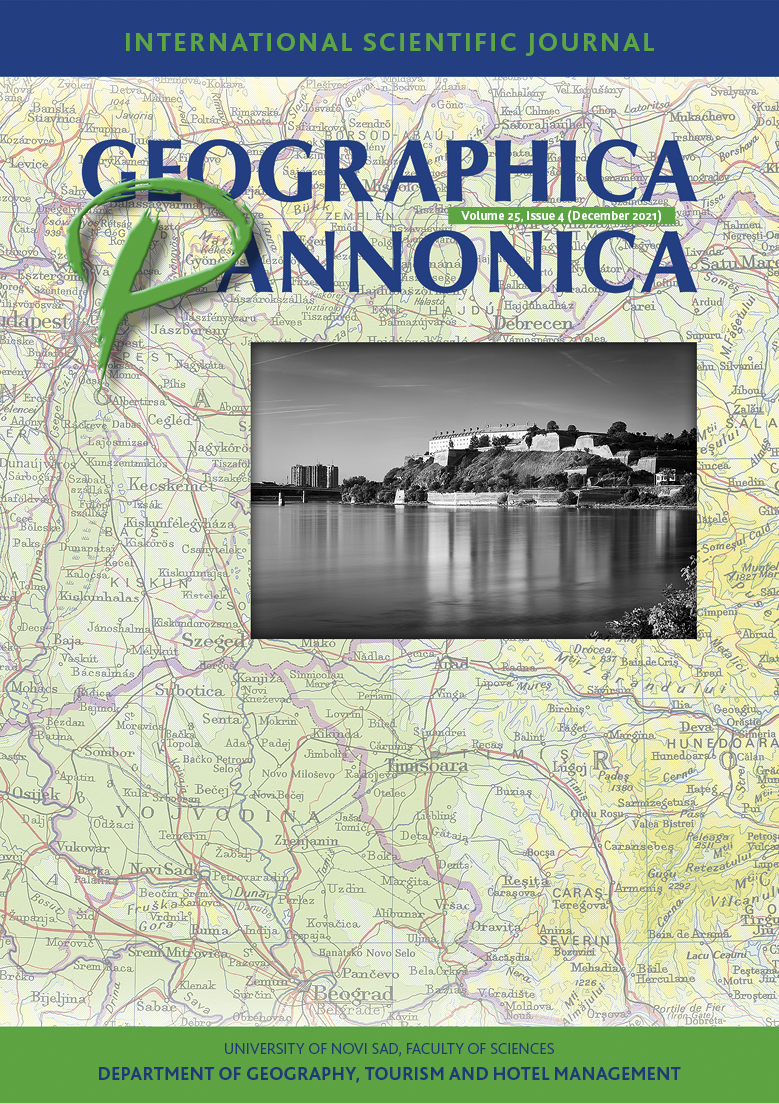The influence of home and school environments on alcoholic beverages, tobacco and marijuana consumption by adolescents in Prague and Brno
Abstract
Excessive use of alcoholic beverages, tobacco or marijuana is problematic not only for adults, but in some countries, it is a significant problem for children. However, the reasons for differences in children's risk behavior, as well as the reasons for risk behavior itself, are not yet fully understood. In this article we focused on the association between the quality of the school and home environment (and their surroundings) as perceived by children themselves and their risk behavior in relation to the use of selected substances. We worked with group of 343 9th grade primary school pupils in different types of neighborhoods. The results of our research show that at least some aspects of the quality of the physical environment have an impact on children's risk behavior.
References
Brooks, F. M., Magnusson, J., Spencer, N., & Morgan, A. (2012). Adolescent multiple risk behaviour: an asset approach to the role of family, school and community. Journal of public health, 34(suppl_1), i48-i56. DOI: 10.1093/pubmed/fds001
Cohen, D. A., Inagami, S., & Finch, B. (2008). The built environment and collective efficacy. Health & place, 14(2), 198-208. DOI: 10.1016/j.healthplace.2007.06.001
Csémy, L., Dvořáková, Z., Fialová, A., Kodl, M., Skývová, M. (2019). Užívání tabáku a alkoholu v České republice 2018, Report. Praha: SZÚ. http://www.szu.cz/uploads/documents/szu/aktual/uzivani_tabaku_alkoholu_cr_2018.pdf
Duncan, G.A. (2002). Beyond love: A critical race ethnography of the schooling of adolescent Black males. Equity & excellence in education, 35(2), 131-143. DOI: 10.1080/713845286
Dvořáková, M. (2006). Obtíže se školní docházkou a záškoláctví na II. stupni základní školy [online]. Brno, 2006 [cit. 2021-05-03]. Available at: https://is.muni.cz/th/xq2j0/.
Dzúrová, D., Csémy, L., Spilková, J., & Lustigová, M. (2015). Zdravotně rizikové chování mládeže v Česku (1st ed.). Praha: SZÚ, 2015, ISBN: 9788070713433
Ensminger, M. E., Juon, H. S., & Fothergill, K. E. (2002). Childhood and adolescent antecedents of substance use in adulthood. Addiction, 97(7), 833-844. DOI: 10.1046/j.1360-0443.2002.00138.x
ESPAD (2020). ESPAD Report 2019: Results from the European School Survey Project on Alcohol and Other Drugs, EMCDDA Joint Publications, Publications Office of the European Union, Luxembourg. http://www.espad.org/espad-report-2019
Galán, I., Rodríguez-Blázquez, C., Simón, L., Ortiz, C., López-Cuadrado, T., & Merlo, J. (2021). Small area influences on the individual unhealthy lifestyle behaviors: A multilevel analysis of discriminatory accuracy. Health & Place, 67, 102506. DOI: 10.1016/j.healthplace.2021.102506
Handy, S. L., Boarnet, M. G., Ewing, R., & Killingsworth, R. E. (2002). How the built environment affects physical activity: views from urban planning. American journal of preventive medicine, 23(2), 64-73. DOI: 10.1016/s0749-3797(02)00475-0
Hawkins, J. D., Catalano, R. F., & Miller, J. Y. (1992). Risk and protective factors for alcohol and other drug problems in adolescence and early adulthood: implications for substance abuse prevention. Psychological bulletin, 112(1), 64. DOI: 10.1037/0033-2909.112.1.64
Jang, S. J., & Johnson, B. R. (2001). Neighborhood disorder, individual religiosity, and adolescent use of illicit drugs: A test of multilevel hypotheses. Criminology, 39(1), 109-144. DOI: 10.1111/j.1745-9125.2001.tb00918.x
Jessor, R. (1991). Risk behavior in adolescence: A psychosocial framework for understanding and action. Journal of Adolescent Health, 12, 597-605. DOI: 10.1016/1054-139x(91)90007-k
Jessor, R., Donovan, J.E., & Costa, F.M. (1994). Beyond adolescence - problem behavior and young adult development. 2nd ed. Cambridge: Cambridge University Press, pp. 293. ISBN: 9780511878176
Kokkevi, A. (2012). Polydrug use by European adolescent. In Hibell et al. (Eds.). The 2011 ESPAD Report: Substance Use Among Students in 36 European Countries. Stockholm: The Swedish Council for Information on Alcohol and other Drugs, (p. 166-170). DOI: 10.3109/09687630902806715
Krieger, J., & Higgins, D. L. (2002). Housing and health: time again for public health action. American journal of public health, 92(5), 758-768. DOI: 10.2105/ajph.92.5.758
Leatherdale, S. T., & Manske, S. (2005). The relationship between student smoking in the school environment and smoking onset in elementary school students. Cancer Epidemiology and Prevention Biomarkers, 14(7), 1762-1765. DOI: 10.1158/1055-9965.EPI-05-0065
Newcomb, M.D. (1997). Psychosocial predictors and consequences of drag use: a developmental perspective within a prospective study. Journal of addictive diseases, 16(1), 51-89. DOI: 10.1300/J069v16n01_05
Resnick, M. D., Bearman, P. S., Blum, R. W., Bauman, K. E., Harris, K. M., Jones, J., ... & Udry, J.R. (1997). Protecting adolescents from harm: findings from the National Longitudinal Study on Adolescent Health. Jama, 278(10), 823-832. DOI: 10.1001/jama.278.10.823
Reynolds, A. J., Magro, S. W., Ou, S. R., & Eales, L. (2019). Are parent involvement and school quality associated with adult smoking behaviors? Findings from an urban early childhood cohort. Preventive medicine, 127, 105768. DOI: 10.1016/j.ypmed.2019.105768
Spilková, J. (2015). Leisure time preferences and health-risk behavior of teenagers in the post-communist Central European countries. Children's Geographies, 13(4), 435-450. DOI: 10.1080/14733285.2013.848742
The Nanny State Index 2021 (2021). Epicenter Network 2021. http://nannystateindex.org/

